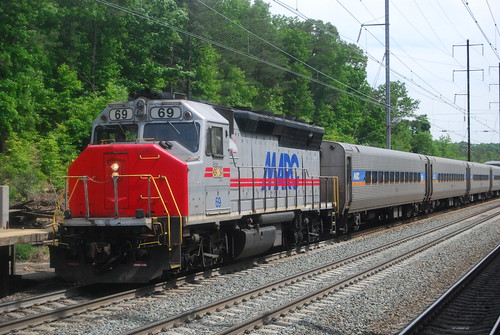
DSC_9921, courtesy of juan.barredo
Two items of interest today for commuters on both sides of the Potomac: Tysons Corner and MARC.
Tysons Corner. It’s a name that sends shivers up most North Virginian commuters’ spines. Notorious for traffic flow “issues” and the spawning of language more suitable for “R” rated movies, the Tysons area is one big, over-bloated, dysfunctional urban mess.
So can it be fixed? Is it really possible to make Tysons a more commuter- and pedestrian-friendly place to be?
The Tysons Land Use Task Force thinks so. In about a month, they’ll be presenting a series of recommendations to the Fairfax County Board of Supervisors to improve the mishmash of parking lots, offices and roadways.
If the recommendations are approved, there could be almost immediate relief for footslogging pedestrians. And no, it won’t be a magical Metro track dropped out of the sky.
Taking a page from downtown DC, the Tysons area would have its own “circulator” bus route. The idea is to have the circulator run often and solely through the Tysons area, transporting residents and workers alike to various points, including the Metro stations. This would hopefully eliminate the need for Metrocentric workers to drive into the area (like yours truly).
Keep in mind the TLUTF still considers the circulator as more of a concept than a reality; the dominant theme on everyone’s mind is still the Tysons Metrorail extension. But if approved, the circulator would need set up quickly – something the task force still needs to address.
Whether the idea comes to fruition or not, it’s heartening to see some alternatives on the table. Banking solely on the Metro extension as the only solution would be a huge mistake. Looking for a short-term solution is something many commuters can get behind these days.
Speaking of short-term solutions, Maryland is getting its act together with regards to the increasing ridership on its MARC system. Plans were announced today that 13 double-decker rail cars are being purchased from the VRE system in an effort to reduce overcrowding.
The $22 million contract was approved this morning by the Board of Public Works.
The passenger cars, similar to 50 other cars on the MARC lines, should be ready for service by November of this year. It’s expected that the new cars will increase passenger coach fleet capacity by 10% and will be first put on the Penn Line.
More improvements are expected in February after MARC receives 26 new locomotives. The new deals with the VRE have allowed the system to add additional capacity four years earlier than if it had gone through a vendor.
The timing couldn’t be better. MARC has had a huge increase in ridership over the last several months, mostly due to high gas prices.
Next problem for MARC to solve? Its chronic delay problems due to locomotive breakdowns. The addition of two electric locomotives that are undergoing rehabilition is one small step towards that issue, but there’s still a long way to go.




You can’t create good walkable things that feel right out of thin air. Anything that gets this “pedestrian” afterthought ends up looking like a Disney main street. You can add all sorts of public transportation, but at the end of the day, Tysons, like the Vegas strip, is a car dominated debacle of 1970s and 1980s architecture and lowest-common-denominator planning.
First thing the Tysons committee should do? Read “A Timeless Way of Building” by Christopher Alexander. Why do old downtowns work? Why are they exciting?
Because a whole lot of people were involved in their creation, not an oligarchical behind-closed-doors group of yuppie wankers.
Regardless of whether the people involved in its creation are yuppie wankers or not, embracing the Circulator policy would greatly aid public transportation users in getting to and from Tysons Corner.